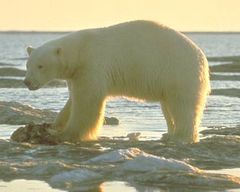 (Updated 12-28) The Bush Administration has formally proposed to list the Polar Bear as “threatened with extinction” under the Endangered Species Act due to Arctic ice melt from global warming. Today’s proposal is groundbreaking for the administration because for the first time it has identified climate change as potentially causing the demise of a species. Once listed, federal agencies will be obligated to ensure that no governmental action jeopardizes the Polar Bear’s continued existence or adversely modifies its critical habitat.
(Updated 12-28) The Bush Administration has formally proposed to list the Polar Bear as “threatened with extinction” under the Endangered Species Act due to Arctic ice melt from global warming. Today’s proposal is groundbreaking for the administration because for the first time it has identified climate change as potentially causing the demise of a species. Once listed, federal agencies will be obligated to ensure that no governmental action jeopardizes the Polar Bear’s continued existence or adversely modifies its critical habitat.
Conservation Groups forced the action by petitioning the government for the listing in February 2005. This year the groups sued when officials failed to meet a deadline seeking their acknowledgment that the bear was facing imminent threat from the disappearance of Arctic sea ice due to the warming of the climate.
“This is a victory for the Polar Bear, and all wildlife threatened by global warming,” said Kassie Siegel of the Center for Biological Diversity, one of three plaintiffs in the suit. “This is a watershed decision in the way this country addresses global warming. There is still time to save Polar Bears but we must reduce greenhouse gas pollution immediately.”
The Center was joined by the Natural Resources Defense Council and Greenpeace in the landmark lawsuit. The U.S. Fish and Wildlife Service now has one year to obtain peer review and public comment on its proposal before deciding to finalize the listing. A recovery plan must then be prepared, specifying measures necessary for its protection.
The government still insists, however, that oil and gas drilling in the Arctic would not affect the Polar Bear populations.
Polar Bears live only in the Arctic and are totally dependent on the sea ice for all of their essential needs. The rapid warming of the Arctic and melting of the sea ice poses an overwhelming threat to the bears, which could become the first mammal to lose 100 percent of its habitat to global warming.
The United States is the largest emitter of the heat-trapping pollution that causes global warming, primarily carbon dioxide emissions from cars and trucks and power plants. States like California are already taking action to cut global warming pollution, but the federal government has been slow to act, refusing to strengthen emission standards for automobiles, for instance.
“Sand in the hourglass is running out for Polar Bears,” said Rep. Jay Inslee, D-Wash., “Congress needs to take bold steps to reduce global warming pollution before time runs out for this and other species.”
The conservation organizations, Center for Biological Diversity, NRDC, and Greenpeace, sued the Bush administration in December 2005 because the government had ignored a petition to protect the Polar Bear. In response, the USF&WS completed the required first “90-day finding” in February 2006, and found that protection of Polar Bears “may be warranted,” and commenced a full status review of the species. The proposed listing is the result of that scientific study.
To date, the government has received more than 200,000 comments in support of listing the Polar Bear, including letters from eminent Polar Bear experts, climate scientists, and more than 35 members of Congress.



















